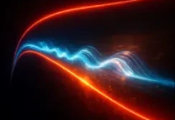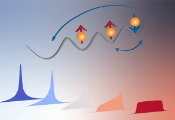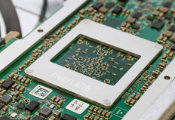Quantum-Inspired Design Boosts Efficiency of Heat-to-Electricity Conversion
November 21, 2024 -- Researchers at Rice University have found a new way to improve a key element of thermophotovoltaic (TPV) systems, which convert heat into electricity via light. Using an unconventional approach inspired by quantum physics, Rice engineer Gururaj Naik and his team designed a thermal emitter that can deliver high efficiencies within practical design parameters.
The research could inform the development of thermal-energy electrical storage, which holds promise as an affordable, grid-scale alternative to batteries. More broadly, efficient TPV technologies could facilitate renewable energy growth ⎯ an essential component of the transition to a net-zero world. Another major benefit of better TPV systems is recouping waste heat from industrial processes, making them more sustainable. To put this in context, up to 20-50% of the heat used to transform raw materials into consumer goods ends up being wasted, costing the United States economy over $200 billion annually.
TPV systems involve two main components - photovoltaic (PV) cells that convert light into electricity and thermal emitters that turn heat into light. Both of these components have to work well in order for the system to be efficient, but efforts to optimize them have focused more on the PV cell.
“Using conventional design approaches limits thermal emitters’ design space, and what you end up with is one of two scenarios: practical, low-performance devices or high-performance emitters that are hard to integrate in real-world applications,” said Naik, associate professor of electrical and computer engineering.
In a new study published in npj Nanophotonics, Naik and his former Ph.D. student Ciril Samuel Prasad - who has since earned a doctorate in electrical and computer engineering from Rice and has taken on a role as a postdoctoral research associate at Oak Ridge National Laboratory ⎯ demonstrated a new thermal emitter that promises efficiencies of over 60% despite being application-ready.
“We essentially showed how to achieve the best possible performance for the emitter given realistic, practical design constraints,” said Prasad, who is the first author on the study.
The emitter is composed of a tungsten metal sheet, a thin layer of a spacer material and a network of silicon nanocylinders. When heated, the base layers accumulate thermal radiation, which can be thought of as a bath of photons. The tiny resonators sitting on top “talk” to each other in a way that allows them to “pluck photon by photon” from this bath, controlling the brightness and bandwidth of the light sent to the PV cell.
“Instead of focusing on the performance of single-resonator systems, we instead took into account the way these resonators interact, which opened up new possibilities,” Naik explained. “This gave us control over how the photons are stored and released.”
This selective emission, achieved through insights from quantum physics, maximizes energy conversion and allows for higher efficiencies than previously possible, operating at the limit of the materials’ properties. To improve on the newly achieved 60% efficiency, new materials with better properties would need to be developed or discovered.
These gains could make TPV a competitive alternative to other energy storage and conversion technologies like lithium-ion batteries, particularly in scenarios where long-term energy storage is needed. Naik noted that this innovation has significant implications for industries that generate large amounts of waste heat such as nuclear power plants and manufacturing facilities.
“I feel confident that what we have demonstrated here, coupled with a very efficient low bandgap PV cell, has very promising potential,” Naik said. “Based on my own experience working with NASA and launching a startup in the renewable energy space, I think that energy conversion technologies are very much in need today.”
The team’s technology could also be used in space applications such as powering rovers on Mars.
“If our approach could lead to an increase in efficiency from 2% to 5% in such systems, that would represent a significant boost for missions that rely on efficient power generation in extreme environments,” Naik said.
The research was supported by the National Science Foundation (1935446) and the U.S. Army Research Office.




































